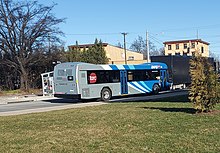Transit Authority of River City
TARC has a number of specialized routes, providing transportation to major local employers, educational institutions, and recreational events.
TARC was created in 1971 after 1970 legislation authorized city and county governments to operate mass-transit systems with local funding.
[3] The local government began subsidizing fares in July 1973, but this was not enough to make the Louisville Transit Company profitable.
[4] Combined with a federal grant, this was enough for TARC to purchase the Louisville Transit Company, buy new buses, reduce fares, and create new service lines.
[3] In 1993, TARC experimented with water-taxi service connecting the Belle of Louisville wharf and Towboat Annie's Restaurant in Jeffersonville.
[5] During the 1990s and early 2000s, TARC advocated extensive funding to build and operate light rail in the Louisville area; despite wide press coverage, the plans never bore fruit.
[citation needed] In February 1994, an audit committee headed by Bruce Lunsford found that TARC had been mismanaging funds and was depleting its once-large trust fund with increasing expenses such as door-to-door service for the disabled and spending on personal services and fringe benefits for administrators which was higher than that of transit companies in similarly sized cities.
[7] In August 2011, TARC's new $4.5 million, 17,700-square-foot Maintenance and Training Annex received a Gold LEED (Leadership in Energy and Environmental Design) Certification.
Thirteen more updated buses were due to arrive by late 2016, increasing the company's ULSD fleet to 95.
Electric buses began operation in downtown Louisville in early 2015 and, according to the Courier Journal, share the 8th Street charging station with a trolley route.
[3] In 2003, TARC significantly remodeled Union Station for the first time since it purchased the facility; the renovation cost $2.1 million.
[needs update] Fares cover only about 12 percent of the company's operating expenses; the rest is from Jefferson County's occupational tax, federal aid, and minor sources.
[11] The occupational tax, 0.002 percent, covers about two-thirds of TARC's annual operating expenses; the total varies with the availability of federal grants and fares collected.
The fund contained $28 million in 1992, which a local alderman said made TARC the "Cadillac" of America's bus systems.
TARC also operates a fleet of 17 electric buses, reducing diesel emissions by 11,000 pounds (5,000 kg).
A previous grant, through the federal stimulus program, paid for nine hybrid buses which arrived in July of that year.
TARC once required disabled riders to use a paratransit service which had to be scheduled in advance, but all regular buses were made accessible after protests in 1986.
The company operates two routes shuttling workers to Worldport, the hub of United Parcel Service and one of Louisville's largest employers.
[22] TARC launched a "Ride to Safety" program in 2007, which allows domestic abuse victims to use its buses for transportation to a shelter.
The shuttle operation transported tens of thousands of people each year and provided TARC with over $200,000 of annual revenue.
[25] TARC provides service to other local events, including Thunder Over Louisville and the Kentucky State Fair.
TARC has begun installation of Computer Aided Dispatch, and Automated Vehicle Location on its buses.
Smart cards would be accepted at a discount fare of $1.50, and riders paying cash would have to have exact change.
TARC began an automated fare-collection system with new magnetic fare cards on January 7, 2019, and launched a new app.



